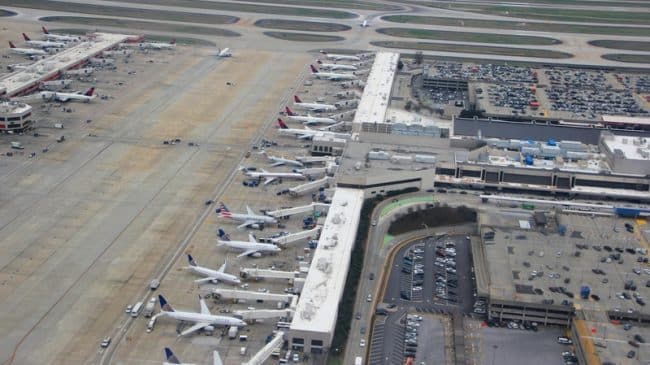Atlanta’s Hartsfield-Jackson International Airport had 96 million passengers pass through it in 2014, making it the busiest airport in the world according to Airports Council International. So it isn’t a surprise that the airport is operating near capacity.
Airport passenger traffic has grown 5 percent and airplane movements are up 3 percent so this year is poised to be the world’s busiest airport’s busiest year ever.
Ideally, a region of Atlanta’s size would have two or more commercial service airports. With 5.6 million people, Atlanta is the only region of its size in the country without a second airport. Assuming Atlanta remains a one-airport region, there are going to be several needs in coming years.
Parking is an issue for customers and employees. During the busiest days of the year, every domestic airport parking lot is full. As a result, many airport passengers must use off-airport parking sites. Between 34 and 51 percent (6,800-10,000 vehicles) of current off-airport parking users would park at the airport if space permitted. The airport plans to replace the existing parking decks with two new eight-story structures for customers and will add lots for employees.
Certain airport roadways and passenger drop-off and pick-up areas are deficient. Some areas are serving twice as many vehicles as they were designed for. And poorly designed roadways are causing congestion and traffic accidents. The airport’s improvements of curb usage, automated vehicle detection and passenger signals will help but they may not be enough.
During busy connecting times in mornings and afternoons, restroom availability is a problem. While it is not included in the plan, the airport should investigate expanding existing or adding additional restrooms, particularly on the T, A and B concourses.
Airport gates to board passengers are another need. The airport has 207 gates, 188 of which are usable. The remaining gates are too close together for today’s larger airplanes. While Southwest Airlines recently gave up some gates, a recent check revealed only four potentially open gates. But with the rapid growth of ultra low-cost carriers like Frontier Airlines and Spirit Airlines serving Atlanta, gates aren’t likely to stay vacant for long.
The plan to add new international concourses G, H and I would provide sufficient gates, but adding gates to the existing concourses would better serve domestic passengers. Domestic service is growing much faster than international service. The airport may be able to add gates to the north and south sides of concourses A, B and C and the south side of D. This would require moving or downgrading two of the taxiways, but it is a tradeoff worth examining. There may also be room to add new gates to Concourse E by adding a parallel mini-concourse with gates east of the existing terminals and located north of gate E18 and south of gate E17.
Increasing flight operations may necessitate adding a new runway by 2025. The addition of a sixth closely spaced south midfield runway makes sense; however, its proximity to other runways will only provide a modest capacity increase. With the new proposed gate complex to the east of Terminal F, the airport should consider a widely spaced north runway.
Airport construction is not cheap. The major funding source for Atlanta’s construction is likely to be passenger facility charges (PFCs). PFCs are a true user fee; only those who fly out of the airport pay them. As a result of inflation, PFCs have lost about 40 percent of their value since 2000. A proposed $2.50 increase to $7.00 is a reasonable way for airports to fund needed improvements.
Finally, one of the biggest airport needs is something the airport has no control over: getting to and from the airport in Atlanta traffic. While the airport is south of I-20, more than 70 percent of airport customers live north of I-20. Many trips to the airport take at least an hour even when traffic is flowing freely. During heavy traffic, the unpredictability of Atlanta’s congestion causes customers and employees to build in buffer time.
As a result, many airport and airline employees are forced to live in close proximity to the airport. Georgia DOTs proposed express lane network could reduce travel times for existing customers and spur greater airport usage. Express lanes on I-285 in the short-term and the proposed north-south expressway/tunnel connecting SR 400 and I-675 with a spur to I-85 south in the long term could increase airport accessibility.
More people flew through Atlanta Hartsfield-Jackson than any other airport in the world. Atlanta has work to do to keep up with traveler’s demands.
Baruch Feigenbaum is Assistant Director of Transportation Policy at Reason Foundation. This article originally appeared in the Atlanta-Journal Constitution.

